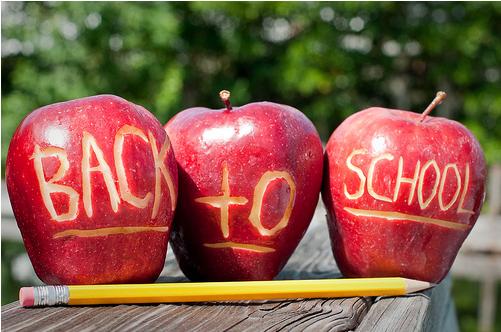
School is starting and if you're like most parents, you're dealing with stresses of rushing, too many activities, and not enough time for cooking. It's important for the children to have nutritious meals, as a hungry child can't learn... and a child "full" on junk food is still hungry.
* Breakfast - Give your child’s brain the nutrition it needs to function at its best. Include protein and a healthy fat, such as avocado, nuts, olives. Keep the grains low and make them whole grain.
* Lunch - Leftovers from suppers - when you’re cooking supper, make extras and freeze in individual serving containers for lunches. Use glass or wrap in parchment paper before putting in plastic bags, containers or wrapping with foil. FYI - the dollar store has glass containers, pre-cut sheets of parchment paper and foil, as well as plastic containers. Include vegetables that are crunchy, such as raw sliced carrots, celery, cucumber. TIP: Slice the large carrots instead of buying baby carrots, which are processed. For a healthy dip, try hummus - easy to make, gluten and dairy free. Include a piece of whole fruit or a handful of berries. Berries can be frozen and will be just right by lunch time. And for dessert? Here’s a great recipe a colleague developed for gelatin gummies. Gelatin has multiple health benefits, which are mentioned in the recipe. sour-watermelon-gummies
* After school snacks - Fruit cocktail - cut up a variety and mix the bite sized pieces together in a container. The juices from the variety make a very nice sweet flavour, without adding extra sugar, as in canned fruit cocktail. Include kiwi - Containing almost 20 vital nutrients, including five times the vitamin C of an orange in one serving, kiwis can legitimately be called a super fruit. This fuzzy brown powerhouse with the bright green flesh also is rich in vitamin A, K, E and B, potassium, copper, folate, and fiber.
For a special treat, top with coconut whipped cream. Coconut milk contains the beneficial fat called lauric acid, a medium-chain fatty acid that's easily absorbed and used by the body for energy. Whip full-fat, organic coconut "cream" (strain out the milk and whip the remaining thick cream) along with a little local honey or maple syrup for a dairy-free treat that is perfect as a topping for fresh fruit!
A handful of mixed nuts if there are no allergies, makes great snack, especially on the go. Nuts are high in protein, fibre, and healthy fats, and the various nuts have other benefits, as well. Moderation is the key. A fistful is a serving. Alternatively, make your own Trail Mix - assorted nuts and seeds (raw), dark chocolate chips, and raisins are a great combination.
Veggies and dip - A fun snack that children can make is "Ants on a Log" - spread peanut butter or almond butter on a celery stick, then stick on raisins. Fun to make and fun to eat.
* Involve the children in the planning process, as well as the preparation and cooking.
* Use the internet together and come up with recipes.
* Let them help combine the ingredients for Trail Mix and make hummus.
When you find recipes the family enjoys, print them and save them in your own family cookbook binder or folder for future reference. Make notes on them and decorate. Let the children do the artwork on the recipes and the cover, either by drawing and colouring or using your phone to take photos of the family cooking together and finished products or using art found on the internet.
Find a day and time when activities are at their slowest and make it a cooking and prep time, stocking up on sliced veggies, making and bagging nut mixes, making hummus (make a large batch and freeze in small containers). You can even make your own almond butter if you have a good blender or food processor.
Chocolate lovers tip: Buy high quality chocolate candy bars (avoid corn syrup as an ingredient) - gradually increase the cocoa content until your children (and you) are eating at least 70% dark chocolate. Two squares is a good serving. When wrapping items in foil, place the shiny side to the food (the dull side is plasticized).
Even with healthy options added to your child's diet, of course, junk will be included. It's ok - better not to deprive them of those "treats", as that will just cause cravings. Try to keep the healthy / unhealthy ration to 80-20%. Even then, most children will need some supplementation. Almost all of us lack enough Fiber, Probiotics, and Essential Fatty Acids (Omega’s) in our diets and need supplementation. That includes children, as well. It's always best to talk to your pharmacist or other healthcare provider about your unique situation for recommendations on these supplements and whether or not a multi-vitamin is needed. Remember, though, taking vitamins is NOT a substitute for healthy food. Foods have combinations of nutrients in them that synergistically work better together, rather than in an isolated "pill". Vitamins and supplements are just that - SUPPLEMENTS to a healthy diet, to make up for what we can't get or don't get enough of in our diets.
For more information, questions about the information provided, please contact us at This email address is being protected from spambots. You need JavaScript enabled to view it. or use the contact us link on our website - fordrx.com/contact or make an appointment to come see us at 506-853-0830! We'd love to talk to you, meet your children, and help your family with a healthy meal plan with foods everyone likes!






